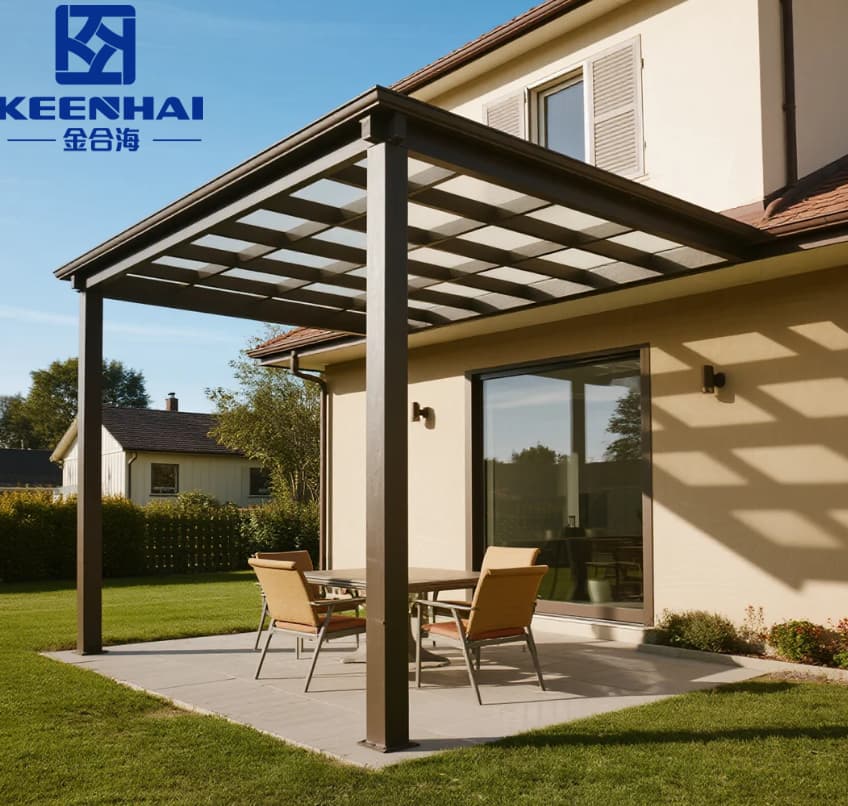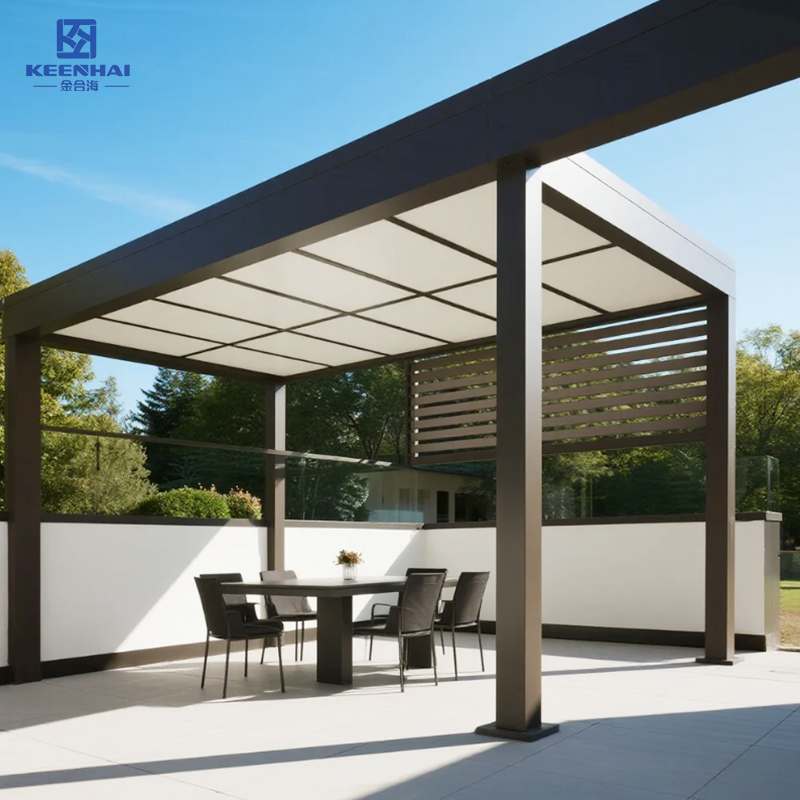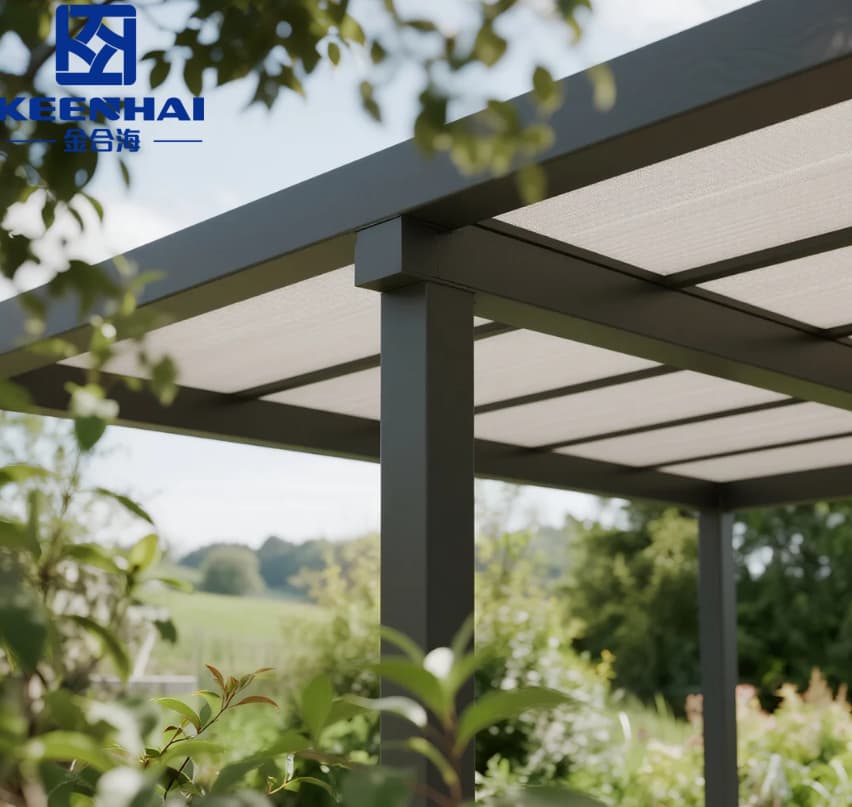
1.Material Comparison
1.1 Strength and Structural Integrity
When it comes to load-bearing strength, aluminium pergolas easily outperform traditional wood. An aluminium frame doesn’t warp when exposed to heavy rain or direct sun, and its beams can span longer distances without sagging. Imagine building a 12x14 ft patio cover—wood often needs a center post for support, while an aluminium pergola can stay completely open, giving you an unobstructed outdoor living space.
Another practical advantage is that aluminium systems are designed with modular joints. This means you can extend them across larger patios or rooftop terraces without worrying about weakening the structure. Many hotels and restaurants choose aluminium because they can handle constant use and weather changes while still keeping a modern, polished look.
1.2 Weight and Installation Considerations
One of the most noticeable differences is weight. Aluminium is far lighter than dense hardwood, yet it doesn’t compromise stability. This makes installation much quicker. For example:
-
Two people can assemble a 10x12 ft aluminium pergola within 3 days.
-
With pre-drilled parts and snap-fit joints, most of the work is just tightening bolts.
-
No heavy lifting equipment is required—unlike with wood, where large beams often need extra manpower or machinery.
Here’s a quick comparison of installation factors:
| Feature | Aluminium Pergola | Wood Pergola |
|---|---|---|
| Average weight (10x12 ft) | ~180–220 lbs | ~350–450 lbs |
| Typical installation team | 2 people | 3–4 people |
| Average installation time | 3 days | 5–7 days |
| Need for special tools | Basic hand tools | Power saws, heavy-duty drills |
Because of this, aluminium is the go-to for DIY enthusiasts or homeowners who don’t want to deal with the mess of cutting and staining wood.
1.3 Resistance to Weather and Pests
Weather resistance is where aluminium truly shines. It doesn’t absorb moisture, so you won’t face swelling, cracking, or rot. Wood pergolas, on the other hand, need yearly sealing or staining to prevent damage. In a humid climate, untreated wood can host termites or carpenter ants within a year.
Consider a coastal home with salty air. A wooden pergola starts to discolor and weaken after two summers, while an aluminium pergola house maintains its finish without extra coatings. The same applies to desert homes where the sun is brutal—aluminium won’t dry out or split.
Real-world scenario: A family in Florida replaced their cedar pergola after 6 years due to termite damage. They installed an aluminium alternative and haven’t done any major upkeep for over 8 years, enjoying the space every summer without worry.

2.Maintenance and Longevity
2.1 Cleaning Requirements
Keeping an aluminium pergola looking fresh is surprisingly easy. Since the surface is smooth and non-porous, dirt and dust don’t stick the way they do on wood. A typical homeowner can clean a 10x12 ft aluminium pergola in under an hour using just a garden hose and mild soap.
Here’s a simple routine most people follow:
-
Rinse the frame with water to wash off loose dirt.
-
Mix a bucket of warm water with a few drops of dish soap.
-
Use a soft sponge to wipe down beams and posts—no scrubbing needed.
-
Rinse again and let it air-dry naturally.
In contrast, a wooden pergola needs sanding, staining, and resealing almost every season. That’s why many families who used to own wood have switched to aluminium—it gives them back weekends that would otherwise be spent maintaining outdoor structures.
2.2 Protective Treatments and Coatings
Aluminium doesn’t require paint or sealant to resist weather, but powder coating adds an extra layer of style and durability. The coating process bonds color into the metal, so even in direct sun, the shade holds strong without peeling. A dark bronze or matte black finish can stay consistent for over a decade.
Wood pergolas need far more effort:
-
Annual staining to block UV rays.
-
Waterproof sealants every 1–2 years.
-
Pest-control treatments in humid areas.
Meanwhile, aluminium pergolas or even a Aluminum Modern Gazebo come factory-finished with coatings that never need touch-ups. This is why hotels and restaurants often choose them—they can set it up once and focus on customers instead of maintenance.
2.3 Expected Lifespan
The difference in lifespan is where the investment really pays off. A properly built wood pergola lasts around 8–12 years if you stay on top of upkeep. In coastal or rainy climates, that number can shrink to 6 years. Aluminium pergolas, on the other hand, regularly stay solid for 25–30 years without any major repairs.
Think of it this way:
-
A family in California installed an aluminium pergola in their backyard patio in 2010. More than a decade later, the frame still looks new, despite being exposed to constant sun.
-
A neighbor with a cedar pergola had to replace several beams after 7 years due to rot and termites.
A single installation can last more than double the lifespan of wood, and that’s the main reason many homeowners lean toward aluminium—it’s a one-time project with long-term comfort.

3.Design Flexibility and Aesthetics
3.1 Available Shapes and Sizes
One of the biggest aluminium pergola benefits is the ability to customize dimensions without compromising strength. Standard wood pergolas are often limited to rectangular layouts because wood beams can only span certain lengths before sagging. Aluminium, however, can handle larger spans with slimmer profiles. For example, a 10x16 ft aluminium pergola can be installed with just four posts, while a wooden version of the same size would usually require six for stability.
Here’s a quick comparison:
| Feature | Aluminium Pergola | Wood Pergola |
|---|---|---|
| Max span without extra posts | 16 ft | 10–12 ft |
| Beam thickness (avg.) | Slim (2–3 in) | Thick (4–6 in) |
| Shape flexibility | Rectangle, square, L-shaped, curved | Mostly rectangle, square |
A real-life example: a family in Texas wanted an L-shaped pergola wrapping around their pool. The contractor recommended an Aluminium Pergola because it could be engineered in one continuous structure, while wood would have required multiple joints and support posts that would interrupt the open feel.
3.2 Color and Finish Options
When it comes to aesthetics, aluminium clearly outshines wood. With powder coating, aluminium pergolas can be finished in over 200+ color options—from matte black to sandy beige or even metallic bronze. These coatings are baked on at high temperatures, meaning they resist fading and chipping. Wood pergolas, on the other hand, rely on paint or stain, which needs refreshing every 1–2 years as part of wood pergola maintenance.
For modern homes, designers often choose minimalist tones like charcoal gray or white to match sleek patio furniture. In contrast, rustic homes may go for a wood-grain powder coat that mimics cedar but without the upkeep. One restaurant in Miami selected a bronze finish for its aluminium pergola to match the outdoor bar; five years later, the shade looks exactly the same despite constant salt-air exposure.
3.3 Integration with Outdoor Spaces
The adaptability of aluminium frames makes it easier to integrate with gardens, decks, or patios. For instance, if someone is installing a modern outdoor gazebo next to a pergola, aluminium allows both to share design language with matching finishes and proportions.
When homeowners plan integration, the process usually involves:
-
Measuring the patio or deck footprint.
-
Choosing a pergola size that aligns with furniture placement.
-
Matching finish and color to railing, decking, or nearby gazebos.
-
Adding accessories such as retractable canopies, lighting, or privacy screens.
One homeowner in California installed a 12x14 ft aluminium pergola above a deck dining area. The slim black frame aligned with their glass railing system, creating a seamless transition between indoor and outdoor living. The contractor noted that with wood, achieving the same level of precision would have required thicker beams and more frequent upkeep, adding both visual bulk and higher costs.

4.Cost Analysis
4.1 Initial Purchase and Installation Costs
The aluminium pergola installation cost is typically higher upfront than building with wood. On average, a 10x12 ft aluminium pergola ranges from $4,500–$7,000 installed, depending on design complexity and add-ons like retractable roofs. Wood versions of the same size often fall between $3,000–$5,000, but that lower entry price comes with trade-offs.
The real advantage shows in installation. Aluminium kits are pre-engineered with interlocking beams, so two people can assemble a 10x12 ft model in about three days using standard tools. Wood pergolas require more cutting, sanding, and sealing, often stretching installation to a week with added labor costs. A contractor in Arizona noted that his crew charges 30% less in labor for aluminium projects because of the simplified assembly.
| Pergola Type | Avg. Initial Cost (10x12 ft) | Avg. Labor Time | Complexity |
|---|---|---|---|
| Aluminium Pergola | $4,500–$7,000 | 3 days (2 ppl) | Pre-engineered kit |
| Wood Pergola | $3,000–$5,000 | 5–7 days (2–3 ppl) | Custom cutting & sealing |
4.2 Long-Term Maintenance Expenses
Where aluminium really pays off is in upkeep. Powder-coated aluminium does not rot, warp, or require sealing. Homeowners in humid regions report that after five years, the only effort has been a quick rinse with a garden hose every few months. By contrast, wood pergola maintenance can quickly add up—staining every 2–3 years at $300–$600 per session, plus occasional board replacement due to rot or termite damage.
A homeowner in Florida shared that her cedar pergola cost $1,200 in upkeep over six years, while her neighbor’s Aluminium Pergola, installed at the same time, still looks brand new with zero additional cost.
4.3 Resale Value Considerations
Buyers today place real value on low-maintenance outdoor structures. Realtors consistently highlight aluminium pergolas as selling points in modern listings, especially in warmer states where weather can punish wood quickly. A study of recent property sales in California showed that homes with aluminium pergolas saw an average ROI of 70–80%, while wood pergolas averaged closer to 50–55%, largely because buyers factored in expected upkeep.
For families thinking long-term, aluminium becomes part of the home’s “move-in ready” appeal. One real estate agent noted that a backyard featuring an aluminium pergola paired with a modern outdoor gazebo increased buyer offers by nearly $15,000 over comparable homes without those upgrades.
